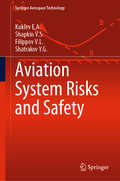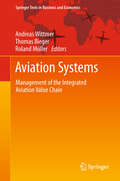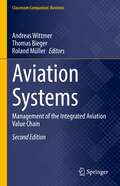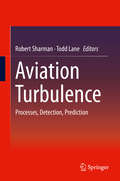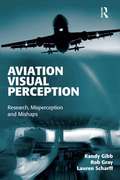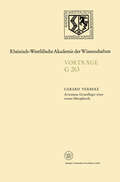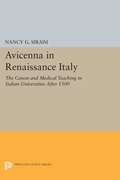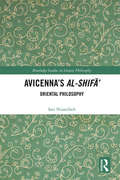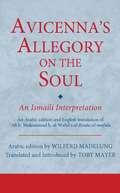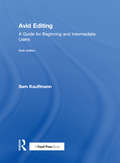- Table View
- List View
Aviation System Risks and Safety (Springer Aerospace Technology)
by Kuklev E.A. Shapkin V.S. Filippov V.L. Shatrakov Y.G.This book provides a solution to “rare event” problems without using the classical theory of reliability and theory of probability. This solution is based on the methodology of risk assessment as “measure of danger” (in keeping with the ICS RAS) and an expert approach to determining systems’ safety indications using Fuzzy Sets methods. Further, the book puts forward a new concept: “Reliability, Risks, and Safety” (RRS). The book’s main goal is to generalize present results and underscore the need to develop an alternative approach to safety level assessment and risk management for technical (aviation) systems in terms of Fuzzy Sets objects, in addition to traditional probabilistic safety analysis (PSA). The concept it proposes incorporates ICAO recommendations regarding proactive system control and the system’s responses to various internal and external disturbances.
Aviation Systems: Management of the Integrated Aviation Value Chain (Springer Texts in Business and Economics)
by Andreas Wittmer, Thomas Bieger and Roland MüllerThis book aims to provide comprehensive coverage of the field of air transportation, giving attention to all major aspects, such as aviation regulation, economics, management and strategy. The book approaches aviation as an interrelated economic system and in so doing presents the “big picture” of aviation in the market economy. It explains the linkages between domains such as politics, society, technology, economy, ecology, regulation and how these influence each other. Examples of airports and airlines, and case studies in each chapter support the application-oriented approach. Students and researchers in business administration with a focus on the aviation industry, as well as professionals in the industry looking to refresh or broaden their knowledge of the field will benefit from this book.
Aviation Systems: Management of the Integrated Aviation Value Chain (Classroom Companion: Business)
by Andreas Wittmer Thomas Bieger Roland MüllerThis book provides an overview of the aviation sector by focusing on all major aspects embedded in the environment (subsystems) and the market of aviation. The book explains the linkages between subsystems politics, society, technology, economy, environment, and regulation, and how these subsystems influence each other and the market. The book starts by describing the aviation system, then focuses on the supply side and the demand side of the system and in a final part focuses on steering and controlling the system of aviation from a managerial, economic, and regulatory perspective. Examples and case studies of airports, airlines, and the production industry in each chapter support the application-oriented approach. The summary and review questions help the reader to understand the focus and main messages of each chapter. Students and researchers in business administration with a focus on aviation, as well as professionals in the industry looking to refresh or broaden their knowledge in the field will benefit from this book.
Aviation Terrorism and Security (Political Violence)
by Paul Wilkinson Brian JenkinsFirst Published in 1999. Routledge is an imprint of Taylor & Francis, an informa company.
Aviation Terrorism and Security (Political Violence #No. 6)
by Paul Wilkinson Brian JenkinsFirst Published in 1999. Routledge is an imprint of Taylor & Francis, an informa company.
Aviation Training: Learners, Instruction and Organization
by Ross A.Telfer Phillip J. MooreThe book is in three parts, which consider training from the perspective of the learner, the instructor and the organization. Its intended readership includes civil and military training and senior pilots, flying instructors, check pilots, CRM facilitators, Human Factors and safety departments, and aviation and educational psychologists as well as those in operations and air traffic management and regulatory authorities.
Aviation Training: Learners, Instruction and Organization
by Ross A.Telfer Phillip J. MooreThe book is in three parts, which consider training from the perspective of the learner, the instructor and the organization. Its intended readership includes civil and military training and senior pilots, flying instructors, check pilots, CRM facilitators, Human Factors and safety departments, and aviation and educational psychologists as well as those in operations and air traffic management and regulatory authorities.
Aviation Trends in the New Millennium
by Ruwantissa I.R. AbeyratneThis timely and authoritative book addresses the commercial and liability issues following commercial aviation into and beyond the year 2000.
Aviation Trends in the New Millennium
by Ruwantissa I.R. AbeyratneThis timely and authoritative book addresses the commercial and liability issues following commercial aviation into and beyond the year 2000.
Aviation Turbulence: Processes, Detection, Prediction
by Robert Sharman Todd LaneAnyone who has experienced turbulence in flight knows that it is usually not pleasant, and may wonder why this is so difficult to avoid. The book includes papers by various aviation turbulence researchers and provides background into the nature and causes of atmospheric turbulence that affect aircraft motion, and contains surveys of the latest techniques for remote and in situ sensing and forecasting of the turbulence phenomenon. It provides updates on the state-of-the-art research since earlier studies in the 1960s on clear-air turbulence, explains recent new understanding into turbulence generation by thunderstorms, and summarizes future challenges in turbulence prediction and avoidance.
Aviation Visual Perception: Research, Misperception and Mishaps (Ashgate Studies in Human Factors for Flight Operations)
by Randy Gibb Rob Gray Lauren ScharffVision is the dominant sense used by pilots and visual misperception has been identified as the primary contributing factor in numerous aviation mishaps, resulting in hundreds of fatalities and major resource loss. Despite physiological limitations for sensing and perceiving their aviation environment, pilots can often make the required visual judgments with a high degree of accuracy and precision. At the same time, however, visual illusions and misjudgments have been cited as the probable cause of numerous aviation accidents, and in spite of technological and instructional efforts to remedy some of the problems associated with visual perception in aviation, mishaps of this type continue to occur. Clearly, understanding the role of visual perception in aviation is key to improving pilot performance and reducing aviation mishaps. This book is the first dedicated to the role of visual perception in aviation, and it provides a comprehensive, single-source document encompassing all aspects of aviation visual perception. Thus, this book includes the foundations of visual and vestibular sensation and perception; how visual perceptual abilities are assessed in pilots; the pilot's perspective of visual flying; a summary of human factors research on the visual guidance of flying; examples of specific visual and vestibular illusions and misperceptions; mishap analyses from military, commercial and general aviation; and, finally, how this knowledge is being used to better understand visual perception in aviation's next generation. Aviation Visual Perception: Research, Misperception and Mishaps is intended to be used for instruction in academia, as a resource for human factors researchers, design engineers, and for instruction and training in the pilot community.
Aviation Visual Perception: Research, Misperception and Mishaps (Ashgate Studies in Human Factors for Flight Operations)
by Randy Gibb Rob Gray Lauren ScharffVision is the dominant sense used by pilots and visual misperception has been identified as the primary contributing factor in numerous aviation mishaps, resulting in hundreds of fatalities and major resource loss. Despite physiological limitations for sensing and perceiving their aviation environment, pilots can often make the required visual judgments with a high degree of accuracy and precision. At the same time, however, visual illusions and misjudgments have been cited as the probable cause of numerous aviation accidents, and in spite of technological and instructional efforts to remedy some of the problems associated with visual perception in aviation, mishaps of this type continue to occur. Clearly, understanding the role of visual perception in aviation is key to improving pilot performance and reducing aviation mishaps. This book is the first dedicated to the role of visual perception in aviation, and it provides a comprehensive, single-source document encompassing all aspects of aviation visual perception. Thus, this book includes the foundations of visual and vestibular sensation and perception; how visual perceptual abilities are assessed in pilots; the pilot's perspective of visual flying; a summary of human factors research on the visual guidance of flying; examples of specific visual and vestibular illusions and misperceptions; mishap analyses from military, commercial and general aviation; and, finally, how this knowledge is being used to better understand visual perception in aviation's next generation. Aviation Visual Perception: Research, Misperception and Mishaps is intended to be used for instruction in academia, as a resource for human factors researchers, design engineers, and for instruction and training in the pilot community.
Avicenna: His Life and Works (Routledge Library Editions: Islamic Thought in the Middle Ages)
by Soheil M. AfnanThis book, first published in 1958, examines the life and works of Avicenna, one of the most provocative figures in the history of thought in the East. It shows him in the right historical perspective, as the product of the impact of Greek thought on Islamic teachings against the background of the Persian Renaissance in the tenth century. His attitude can be of guidance to those in the East who are meeting the challenge of Western civilization; and to those in the West who have yet to find a basis on which to harmonize scientific with spiritual values.
Avicenna: His Life and Works (Routledge Library Editions: Islamic Thought in the Middle Ages #1)
by Soheil M. AfnanThis book, first published in 1958, examines the life and works of Avicenna, one of the most provocative figures in the history of thought in the East. It shows him in the right historical perspective, as the product of the impact of Greek thought on Islamic teachings against the background of the Persian Renaissance in the tenth century. His attitude can be of guidance to those in the East who are meeting the challenge of Western civilization; and to those in the West who have yet to find a basis on which to harmonize scientific with spiritual values.
Avicenna (Arabic Thought and Culture)
by L E Goodmanthe philosophers in the West, none, perhaps, is better known by name and less familiar in actual content of his ideas than the medieval Muslim philosopher, physician, minister and naturalist Abu Ali Ibn Sina, known since the days of the scholastics as Avicenna. In this book the author, himself a philosopher, and long known for his studies of Arabic thought, presents a factual account of Avicenna's philosophy. Setting the thinker in the context of his often turbulent times and tracing the roots and influences of Avicenna's ideas, this book offers a factual philosophical portrait. It details Avicenna's account of being as a synthesis between the seemingly irreconcilable extremes of Aristotelian eternalism and the creationism of monotheistic scripture. It examines Avicenna's distinctive theory of knowledge, his ideas about immortality and individuality, including the famous "floating man argument", his contributions to logic, and his probing thoughts on rhetoric and poetics.
Avicenna (Arabic Thought and Culture)
by L E Goodmanthe philosophers in the West, none, perhaps, is better known by name and less familiar in actual content of his ideas than the medieval Muslim philosopher, physician, minister and naturalist Abu Ali Ibn Sina, known since the days of the scholastics as Avicenna. In this book the author, himself a philosopher, and long known for his studies of Arabic thought, presents a factual account of Avicenna's philosophy. Setting the thinker in the context of his often turbulent times and tracing the roots and influences of Avicenna's ideas, this book offers a factual philosophical portrait. It details Avicenna's account of being as a synthesis between the seemingly irreconcilable extremes of Aristotelian eternalism and the creationism of monotheistic scripture. It examines Avicenna's distinctive theory of knowledge, his ideas about immortality and individuality, including the famous "floating man argument", his contributions to logic, and his probing thoughts on rhetoric and poetics.
Avicenna and the Visionary Recital: (Mythos Series) (PDF)
by Henry CorbinIn this work a distinguished scholar of Islamic religion examines the mysticism and psychological thought of the great eleventh-century Persian philosopher and physician Avicenna (Ibn Sina), author of over a hundred works on theology, logic, medicine, and mathematics. Henry Corbin's discovery in an Istanbul library of the manuscript of a Persian translation of and commentary on Avicenna's Hayy ibn Yaqzan, written in Arabic, led him to an analysis of three of Avicenna's mystical "recitals." These form an initiatory cycle leading the adept along the path of spiritual progress. In Part I Corbin summarizes the great themes that show the philosophical situation of Avicennan man in the cosmos and presents translations of these three great Avicennan recitals. Part II is a complete translation, with notes, of the Persian commentary.Originally published in 1960.The Princeton Legacy Library uses the latest print-on-demand technology to again make available previously out-of-print books from the distinguished backlist of Princeton University Press. These editions preserve the original texts of these important books while presenting them in durable paperback and hardcover editions. The goal of the Princeton Legacy Library is to vastly increase access to the rich scholarly heritage found in the thousands of books published by Princeton University Press since its founding in 1905.
Avicenna, Grundleger einer neuen Metaphysik (Rheinisch-Westfälische Akademie der Wissenschaften #263)
by Gerard VerbekeAvicenna in Renaissance Italy: The Canon and Medical Teaching in Italian Universities after 1500 (PDF)
by Nancy G. SiraisiThe Canon of Avicenna, one of the principal texts of Arabic origin to be assimilated into the medical learning of medieval Europe, retained importance in Renaissance and early modern European medicine. After surveying the medieval reception of the book, Nancy Siraisi focuses on the Canon in sixteenth- and early seventeenth-century Italy, and especially on its role in the university teaching of philosophy of medicine and physiological theory.Originally published in 1987.The Princeton Legacy Library uses the latest print-on-demand technology to again make available previously out-of-print books from the distinguished backlist of Princeton University Press. These editions preserve the original texts of these important books while presenting them in durable paperback and hardcover editions. The goal of the Princeton Legacy Library is to vastly increase access to the rich scholarly heritage found in the thousands of books published by Princeton University Press since its founding in 1905.
Avicenna's Al-Shifā': Oriental Philosophy (Routledge Studies in Islamic Philosophy)
by Sari NusseibehThis book deals with the philosophy of Ibn Sina - Avicenna as he was known in the Latin West- a Persian Muslim who lived in the eleventh century, considered one of the most important figures in the history of philosophy. Although much has been written about Avicenna, and especially about his major philosophical work, Al-Shifa, this book presents the rationalist Avicenna in an entirely new light, showing him to have presented a theory where our claims of knowledge about the world are in effect just that, claims, and must therefore be underwritten by our faith in God. His project enlists arguments in psychology as well as in language and logic. In a sense, the ceiling he puts on the reach of reason can be compared with later rationalists in the Western tradition, from Descartes to Kant –though, unlike Descartes, he does not deem it necessary to reconstruct his theory of knowledge via a proof of the existence of God. Indeed, Avicenna’s theory presents the concept of God as being necessarily presupposed by our theory of knowledge, and God as the Necessary Being who is presupposed by an existing world where nothing of itself is what it is by an intrinsic nature, and must therefore be as it is due to an external cause. The detailed and original analysis of Avicenna’s work here is presented as what he considered to be his own, or ‘oriental’ philosophy. Presenting an innovative interpretation of Avicenna’s thought, this book will appeal to scholars working on classical Islamic philosophy, kalām and the History of Logic.
Avicenna's Al-Shifā': Oriental Philosophy (Routledge Studies in Islamic Philosophy)
by Sari NusseibehThis book deals with the philosophy of Ibn Sina - Avicenna as he was known in the Latin West- a Persian Muslim who lived in the eleventh century, considered one of the most important figures in the history of philosophy. Although much has been written about Avicenna, and especially about his major philosophical work, Al-Shifa, this book presents the rationalist Avicenna in an entirely new light, showing him to have presented a theory where our claims of knowledge about the world are in effect just that, claims, and must therefore be underwritten by our faith in God. His project enlists arguments in psychology as well as in language and logic. In a sense, the ceiling he puts on the reach of reason can be compared with later rationalists in the Western tradition, from Descartes to Kant –though, unlike Descartes, he does not deem it necessary to reconstruct his theory of knowledge via a proof of the existence of God. Indeed, Avicenna’s theory presents the concept of God as being necessarily presupposed by our theory of knowledge, and God as the Necessary Being who is presupposed by an existing world where nothing of itself is what it is by an intrinsic nature, and must therefore be as it is due to an external cause. The detailed and original analysis of Avicenna’s work here is presented as what he considered to be his own, or ‘oriental’ philosophy. Presenting an innovative interpretation of Avicenna’s thought, this book will appeal to scholars working on classical Islamic philosophy, kalām and the History of Logic.
Avicenna's Allegory on the Soul: An Ismaili Interpretation (Ismaili Texts and Translations)
by Wilferd Madelung Toby MayerThe Persian philosopher Ibn Sina (d. 1037), known in Europe as Avicenna, was arguably the greatest master of Aristotelian thought in the Muslim world. The symbolical 'Poem on the Soul' (Qasidat al-nafs), which portrays all earthly human souls as in temporary exile from heaven, is traditionally attributed to him. Renowned for his encyclopaedic treatments of philosophy, Avicenna also experimented with a variety of intellectual genres and discourse styles, including a small number of mythopoeic texts. Among those, the brief Qasida drew the particular attention of commentators on account of its aesthetic impact, popularity and the ostensibly esoteric character of its teachings. It depicts the human soul as a strayed dove, which can only return home after retrieving awareness of its celestial origin. The text therefore expresses the need metaphorically for a philosophical perspective in life and for philosophy as a path to salvation. One of the most important commentaries on the Qasida was written by ?Ali b. Muhammad b. al-Walid (d. 1215), a major early representative of the Tayyibi Ismaili tradition, which emerged and flourished in medieval Yemen. In his view, the poem encapsulated the highly distinctive and esoteric beliefs of his own school. At the heart of this system lies a cosmological myth, aptly named the 'drama in heaven,' according to which our imperfect universe results from a rupture in the celestial world and a subsequent fall. Avicenna's Allegory on the Soul presents the first edition of the Arabic text of Ibn al-Walid's commentary, 'The Useful Epistle' (al-Risala al-mufida), alongside an English translation and extended introduction. It offers invaluable insight into esoteric Muslim thought and a deeper understanding of Avicenna's substantial intellectual legacy.
Avicenna's Allegory on the Soul: An Ismaili Interpretation
I.B.Tauris in association with the Institute of Ismaili StudiesThe Persian philosopher Ibn Sina (d. 1037), known in Europe as Avicenna, was arguably the greatest master of Aristotelian thought in the Muslim world. The symbolical Poem on the Soul (Qasidat al-nafs), which portrays all earthly human souls as in temporary exile from heaven, is traditionally attributed to Avicenna, and was received with enthusiasm by its commentators. A highly significant commentary on the Qasida was written by ?Ali b. Muhammad b. al-Walid (d. 1215 CE), a major early representative of the Tayyibi Ismaili tradition, which emerged and flourished in medieval Yemen. In his view, the poem encapsulated Tayyibi beliefs, whose doctrines bear striking parallels with late antique Gnosticism. Avicenna s Allegory on the Soul presents the first edition of the Arabic text of Ibn al-Walid s commentary, The Useful Epistle (al-Risala al-mufida), alongside an English translation and extended introduction. It offers invaluable insight into the intricacies of Muslim thought and a deeper understanding of Avicenna s substantial intellectual legacy."
Avid Editing: A Guide for Beginning and Intermediate Users
by Sam KauffmannCompletely updated for current HD, UHD, 2K, and 4K workflows, Avid Editing blends the art and aesthetics of motion picture editing with technical, hands-on instruction. Appropriate for beginners and intermediate users who need to refresh their knowledge of essential post-production techniques, this fully revamped and full-color sixth edition is also an excellent tool for editors coming to Avid from other non-linear editing platforms. Topics covered include trimming, audio, effects, titles, color correction, customization, inputting, and outputting. A robust accompanying online eResource features professionally shot footage and Avid project files, allowing readers to work alongside the lessons taught in the book. The new edition covers: Avid Media Composer licensing choices Changes to the Avid user interface Basic and advanced visual effects Mastering Avid’s audio tools Exploring Avid’s Title Tool and NewBlue Titler Pro Understanding double-system sound techniques Syncing picture and sound files Understanding and applying LUTs The latest HD, UHD, 2K, and 4K Workflows
